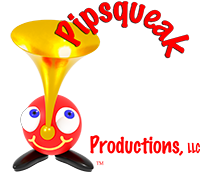Pipsqueak has resisted the temptation to grow larger as a company. We’re small and that’s how we like it. Being small enables us to personally attend to each project that runs through our shop. When you hire Pipsqueak, you’re primarily hiring the talents of its three principals. Most of the work we do ourselves—so if you like the work you see here on our site, you can be assured that the same people are going to be working on your project. However, we do have a loose association with other creative freelancers whose work we admire. We bring these people onto individual projects on an “as needed” basis, which allows us to quickly scale up in response to large projects and to hire people who have skills that we don’t.
Pipsqueak is project oriented and self-directed. While we do plenty of digital production work following a client’s precise instructions, we shine when given the freedom to craft effective solutions to particular communication problems. If we’re brought in early on a project, we can often save a considerable amount of time and money by using our design process and cognitive approach to quickly focus on an optimum solution. Once focused, we’re able to execute with a focus on users and careful attention to detail.
True Costs of an In-house Project
We work on projects as independent contractors. Often, the charges of independent contractors are compared against the costs of doing a project in-house. There are a lot of hidden charges to work performed in-house which need to be included in such an analysis in order to create an accurate financial comparison.
There are a lot of hidden charges to work performed in-house.
Let’s say you decide to do a project in-house. First, there are the human resource costs in attracting and hiring people with an appropriate skill set, if you can find them. Obviously, these employees need to be paid a salary. Less obvious, perhaps, is the amount that health insurance, Worker’s Compensation Insurance, and payroll taxes add—it’s estimated that these costs swell a base salary by an additional third. Are they remote workers? If not, they need heat, light, office space, and furniture. They need training—lots of it. They need computers on which to work. Those computers need lots of software, some of which is quite expensive (consider the cost and time required to obtain and organize a stock photo library). And don’t forget the computer hardware itself: back up drives, uninterruptible power supplies, network hubs, routers, internet access, and robust file servers. All of which needs to be constantly maintained, occasionally upgraded or replaced, and support from IT. Those employees also need other internal support systems—telephone, copier, and other supplies. And they take vacation time, sick time, and personal leaves. Most importantly, you continue to pay them whether you’re using their services or not. So you have to have projects for them all the time. With employees, it’s hard to scale down and it’s hard to scale up.
By contrast, we pay all these expenses ourselves. When you pay our hourly rate or our project price, you don’t have to pay for our equipment, vacations, training, and sick time. We only get paid by you when we’re working on your project.
When you pay our hourly rate, you’re getting more than just our expertise.
How Much Will a Project Cost?
We’d also like to address another issue. New media projects, by their nature, are not clearly defined at the outset. A website, for example, evolves during its creation. No one will know at the beginning of a project how many original illustrations will be required for the site, or how many photographs, or usually even how many pages. But we are often asked, “How much will it cost?” We’re like builders asked to bid on a house without seeing the blueprints.
How can a builder bid on constructing a house without seeing the blueprints?
A builder can make a bid without blueprints if everything is left in her control—choice of site, materials, floor plans, appliances, and the like—she can keep the costs down and, after adding a profit and contingency element to her bid, be reasonably confident of delivering a project for a set cost. On the other hand, if the home owner decides after the bid that he wants twenty foot ceilings, top-of-the-line appliances, redwood siding, granite countertops, copper pipes, and a home theater, that’s going to have a marked impact on the price.
A fixed bid without detailed specs in a home construction project would reverse the appropriate incentives.
A fixed bid without detailed specs in a home construction project reverses the appropriate incentives. The builder’s incentive is to cut corners and use cheap materials. The home owner’s incentive is to jack up the specifications knowing that increasing the quality won’t add to the overall cost. This is not conducive to either building a good house or retaining a harmonious relationship between builder and buyer.
To continue the analogy, the building of custom homes is usually broken into at least two distinct phases. During the first, the home buyer discusses his budget and requirements, and detailed plans are drawn up and agreed upon. During the second phase, fixed bids are made based upon the plans. The first phase has to done before the bids for the second phase can be made.
Our Billing and Design Preference
Our preferred method of working is by providing a rough “guesstimate” and then actually bill based upon time and materials. This way, we don’t assume the risk of a project taking longer than we expected and our clients don’t have to pay a contingency fee. It also puts the incentives where they belong—we don’t have an incentive to cut needed quality, and our clients don’t have an incentive to add needless complexity.
Billing on time and materials takes a great deal of trust between contractor and client.
But billing on time and materials takes trust between contractor and client. It only works if we’re scrupulously honest and, no matter how honest we say we are on our website, we recognize the necessary degree of trust only develops after working with us for a while.
One of the ways we’ve tried to bridge the trust barrier is by documenting in real time our ongoing work on each project. That way, our client can see precisely where we are in a project—what we’ve accomplished and how much we’ve charged for it. When an element or a design has been developed, our client can approve it or easily request a change in direction.
We also like a continuing creative process where design continues during execution. This approach allows design inspiration, which often occurs during the execution of elements, to become incorporated into the project.
Fixed Bid Projects
Fixed bids require that the project is fully defined first.
Some clients have internal constraints that require fixed bids from outside contractors. In those cases, we break projects up into two formal phases—a design phase and a production phase. We bid each separately, with a production bid coming after the completion of the design phase. This can be a cumbersome way to work, imposing an artificial barrier between design and production. It also makes it difficult to accommodate changes in the production stage. In our experience, those changes tend to be inevitable and they impact the cost of projects. But it’s a reasonable solution to the problem: first carefully define the project and then build it.
Tell Us Your Budget!
Building a $1,000,000 house is a different project than building a $300,000 house.
Clients are often wary about revealing their budgets for a project. We’d encourage this information to be shared early during the planning stages, however. It’s like the three bedroom house analogy. If one wants to build a million dollar house, it’s a different project than building a $300,000 house. It’s awfully hard if the architect has to guess which house to design.
If we know what your budget is, and it’s a significant constraint, we can advise you more effectively about where money can be saved and which portions of the project are better left to a later date. If you have a large budget and you tell us (what a happy problem!), we can suggest intelligent ways of spending that money to increase the effectiveness of the final product.
Design Work for Free?
Some people issue a request for proposal that requires the bidder to submit project designs as part of their bid. But design is too important to treat as a throw away. It’s like asking an architect to draw up the plans for a custom house for free. How much thought will an architect will put into understanding the client’s needs during that free design phase? Most likely, the architect will produce canned plans.
We’ve seen web projects done this way and they nearly always fail—they either run wildly over time and budget as the client’s real needs filter into the design process or they get built but, since they weren’t carefully designed to begin with, they don’t achieve their purpose.
Some people try to get design work done for free on a project. But design is too important to treat as a throw away.
Good design pays for itself. The whole point of any project is to be responsive to the needs of the client and its intended users. And that just doesn’t happen without thoughtful design.

